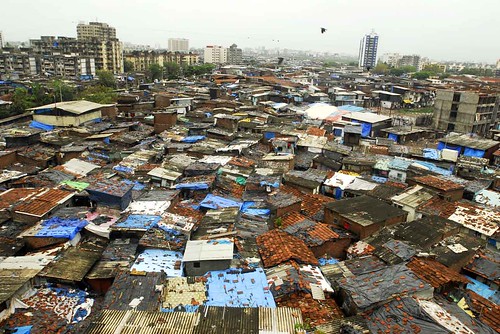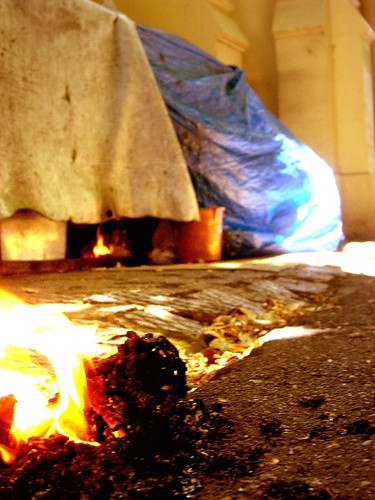(posted earlier this eve at The Orange)

Today as World Habitat Day shines a light on the basic human right to adequate shelter, Mark Horvarth, creator and producer of InvisiblePeople.TV, sits down with progressive talk show host Angie Coiro to discuss homelessness in America. Horvarth, who hails from Los Angeles, swung into San Francisco late last night, at the tail end of his 2 1/2 month roadtrip across America. He has some fine suggestions to share, like a Yelp for nonprofits and an iPhone app to direct volunteers to the nearest location in need of their help.
So tonight, in acknowledgement of WHD, EcoJustice joins Angie and Mark Live from the Left Coast.
(note liveblog will be archived at Green960.com
Let’s go LIVE from the streets of San Francisco!

The number of low-income families in the US that lack safe and affordable housing is related to the number of children that suffer from asthma, viral infections, anemia, stunted growth and other health problems. About 21,000 children have stunted growth attributable to the lack of stable housing; 10,000 children between the ages of 4 and 9 are hospitalized for asthma attacks each year because of cockroach infestation at home; and more than 180 children die each year in house fires attributable to faulty electrical heating and electrical equipment. World Habitat News Facts

Women from Afghanistan, Bolivia, Cameroon, Mail, Sierra Leone, and The Gambia are training to become barefoot solar engineers in Tilonia, home of the Barefoot College in India. After 6 months training in India, they will return to their home countries and solar-electrify their own communities.Link
For a full third of our nation, home is a noteworthy topic. For these 95 million people home isn’t a given. It is a search, a hope, a goal. Whether they have housing problems because of poverty, mental illness, or loss of family, they have them. Many of these people are chronically homeless, and some are working 3 jobs and still unable to afford decent housing for their families.Thoughts on World Habitat Day; Mobile Loaves & Fishes.
What if we could find ways to engage the nation’s homeless in projects which could lead them out of poverty? What if, instead of turning our homeless out onto the streets early each morning, we converted shelters in 21st century workshops… what if we took the ‘bottom up’ localized principles of social entrepreneurship and sustainable development that are most effective in international projects — I’m thinking here of Seva Foundation and India’s Barefoot College, and the phenomenal work of …. hmmm … what was that guy’s name anyway? You know, the one who was hired by the Obama administration to take on molding a community based approach to greening the economy? …. ohhhhhh
…. What if we hired Van Jones to tackle this problem????
(wherein i assemble a mini VJ swag bag)Van Jones Green for All”“Is there anyone here who ever swallowed hard and took a stand for something that you knew was unpopular? Has anybody in this room ever really, really screwed something up, and then tried again? Well, I would say if you answered yes to any of those questions, you are a social entrepreneur.” Van Jones
“Adopt a policy or implement a program that creates environmentally beneficial jobs in slums and/or low-income neighborhoods.”
The adoption of these accords marked the beginning of the global movement for “green jobs.”
… Princeton University professor and political commentator Melissa Harris-Lacewell frames Jones’s resignation as a “kick in the gut” to the environmental justice movement, whose initiatives include creating green jobs and advocating against improper land uses and health problems in poor and minority neighborhoods … Green The Block launches last week in DC and from the Ella Baker Blog “Center for Human Rights where Jones was a co-founder and worked for ten years: “While most Americans would now agree that climate change is real, a new report by the USC Program for Environmental and Regional Equity and UC Berkeley’s College of Natural Resources uncovers what researchers call a “climate gap” or hidden pattern revealing that poor people and people of color in the United States suffer more from environmental changes than other whiter and wealthier Americans.
One more call lauding the extraordinary work of another social entrepreneur, MacArthur Fellowship recipient David Green. Green’s lifework is about providing affordable, accessible and financially self-sustaining health care and medical technology throughout the developing world. Through the Seva Foundation, he partnered with India’s Aurolab to develop an affordable intraocular lens for cataract patients. Aurolab provides intraocular lenses to poor cataract patients at a cost of $4 – $6. (In contract, US manufactures lenses at a cost of $100-$150.) His most recent project, Conversion Sound,is based upon three concepts: wealthy clients pay higer prices to subsidize the lower price of hearing aids to poorer clients; battery prices are lowered through use of a solar or crank-powered battery charger; and non-medical personnel are trained to fit hearing aids in a little over an hour. Additionally, custom molds are manufactured on site utlizing an instant mold making process.
Green says what motivates him is analogous to Chinese acupunture: the redirection of energy from where it is most focused to where it is most needed. He says he doesn’t work with companies;rather, he works with individuals who possess technical competence and deep rooted integrity. Green is currently addressing applicatin of his well-tested concepts of social capitalism in the design of a “Bottom of the pyramid approach to healthcare delivery to develop financially self sustaining paradigms for health services. He recently spoke at a forum in San Francisco discussing this extraordinary paradigm.
Sugggestion: What if we hired Van Jones to handle this problem? And he talked to David Green and they both talked to David Horvarth and then they all get together for a roundtable special on Angie Coiro’s Live From The Left Coast? Maybe we could get something done! (In my attempt to get things started, I’ve got the Ella Baker Center following my tweets and am following the tweets of a wide array of social entrepreneur networks in the hopes I can generate some cross-tweeting.)

As soon as the downpour started the children were out on the streets in the slums of Dhaka, celebrating the rain
One out of every three city dwellers n the world – nearly a billion people – lives in a slum. (Slum indicators include: lack of water, lack of sanitation, overcrowding, non-durable structures and insecure tenure.)

Dharavi – Asia’s largest slum, is located in the centre of Mumbai. Studies show that more than 60 percent of population of Mumbai (formerly known as Bombay) lives in the slums. These slums lack basic infrastructure and is very low in hygenic and health care.
LOS ANGELES – The city attorney stood on the roof of a homeless shelter high above the human misery of Skid Row in April and announced a $1.6 million settlement from a hospital accused of dumping about 150 mentally ill patients on the streets.Rocky Delgadillo trumpeted the penalty, castigated those who took advantage of society’s most vulnerable and praised the Union Rescue Mission’s chief executive as an inspiration for the investigation that led to the settlement.
What seemed like a big payday for the shelter and other nonprofits that have fought homelessness, mental illness and drug abuse on Skid Row for years, however, turned out to be no such bonanza. Instead, the lion’s share went to an organization in Pasadena – a suburb a dozen miles away – to provide grief counseling to school children. Link
Compare this
A member of the Tulag Tribe in Africa comments on the magical moment, as the sun sets, the world settles, the tribespeople get into their tents, boil tea …
VMA: Tell me about a moment of deep happiness for you in the desert.MAA: It happens every day, two hours before sunset. The heat decreases, there is still no cold air, and men and animals slowly return to the compound, and their profiles are painted against a sky that is pink, blue, red, yellow, green.
VMA: That sounds fascinating.
MAA: It’s a magical moment. We all get into the tents and we boil tea. Sitting in silence we listen to the sound of the boiling water. We are immersed in calmness, with our the heart beating to the rhythm of the boiling water, potta potta potta……
VMA: How peaceful.
MAA: Yes…here you have watches; there, we have time.
from LIM News Interview with by Victor-M. Amela with Moussa Ag Assarid, a journalist and member of the Touareg tribe in Africa.
with this …
an American photographer rushes back for his camera to capture a picture of a Hobo’s tent …
i was driving past, the sun was setting, the smoke was brewing, they were still sleeping. i parked and ran back, adjusting the setting to my camera, ready set go. and then the hobos came out of their cardboard house, they didnt realise that the fire was going, they had been saving it. so this one guy stomped it out, while the other guy just sat on the curb and watched the cars go by. (i’ll put that photo up soon).the guy who was sitting on the curb has claimed this yard for years. i used to buy him coffee every morning when i worked around the corner. he used to smile and talk some banter to me. sadly, as the years have passed he has become even more estranged with this world, he no longer talks, he can barely look me in the eyes. he rarely smiles. his smile was once so sweet, the cheekiness of a child.
recently his friend, the guy putting out the fire, set up camp next to him. they watch the people go by, the day go by, silent, but together. Cybele
Photo credits:
World Habitat Day Mosaic
Barefoot Photographers of Tilonia
Please Color My Eyes by Bu Saif
Masai Mara, by Lyndon Firman
Hobo Home by Cybele
The start of the monsoon, 2009-05-17, by Martien Van Asseldonk.
Dharavi, Mumbai by Soumak Kar
Urban Camping by James Hermann
EcoJustice series discuss environmental justice, or the disproportionate impacts on human health and environmental effects on minority communities in the U.S. and around the world. All people have a human right to clean, healthy and sustainable communities.
Almost 4 decades ago, the EPA was created partially in response to the public health problems caused in our country by environmental conditions, which included unhealthy air, polluted rivers, unsafe drinking water and waste disposal. Oftentimes, the answer has been to locate factories and other pollution-emitting facilities in poor, culturally diverse, or minority communities.
Please join EcoJustice hosts on Monday evenings at 7PM PDT. Please email us if you are interested in hosting.





 Living in lush green neighborhoods has provided the rich with a life-saving advantage over the poor who suffer from sweltering heat in concrete jungles. Transforming green open lands into a maze of buildings and roads of cities provided benefits to all of society, but it also creates urban heat islands that cause illness, death and misery that is disproportionately imposed on poor communities.
Living in lush green neighborhoods has provided the rich with a life-saving advantage over the poor who suffer from sweltering heat in concrete jungles. Transforming green open lands into a maze of buildings and roads of cities provided benefits to all of society, but it also creates urban heat islands that cause illness, death and misery that is disproportionately imposed on poor communities. 
